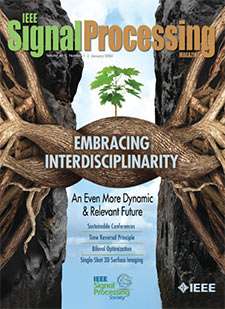The Discrete Cosine Transform and Its Impact on Visual Compression: Fifty Years From Its Invention
Top Reasons to Join SPS Today!
1. IEEE Signal Processing Magazine
2. Signal Processing Digital Library*
3. Inside Signal Processing Newsletter
4. SPS Resource Center
5. Career advancement & recognition
6. Discounts on conferences and publications
7. Professional networking
8. Communities for students, young professionals, and women
9. Volunteer opportunities
10. Coming soon! PDH/CEU credits
Click here to learn more.
The Discrete Cosine Transform and Its Impact on Visual Compression: Fifty Years From Its Invention
Compression is essential for efficient storage and transmission of signals. One powerful method for compression is through the application of orthogonal transforms, which convert a group of
Compression is essential for efficient storage and transmission of signals. One powerful method for compression is through the application of orthogonal transforms, which convert a group of
In January 1974, Ahmed et al. published an article titled “The Discrete Cosine Transform” (DCT) [1]. This seminal article introduced a signal-independent transform, called the DCT, which uses real basis functions from the family of discrete Chebyshev polynomials. The DCT was shown, via numerical examples, to have an energy compaction performance almost as good as the KLT, superior to other well-known signal-independent transforms including the discrete Fourier transform (DFT), Haar transform, and Walsh–Hadamard transform for signals that can be modeled as a first-order Markov process with a correlation coefficient close to one. Furthermore, if the source can be modeled as a Gaussian process, the DCT leads to a rate-distortion bound similar to using the KLT, lower than the DFT. The article also showed that the
SPS on Twitter
- DEADLINE EXTENDED: The 2023 IEEE International Workshop on Machine Learning for Signal Processing is now accepting… https://t.co/NLH2u19a3y
- ONE MONTH OUT! We are celebrating the inaugural SPS Day on 2 June, honoring the date the Society was established in… https://t.co/V6Z3wKGK1O
- The new SPS Scholarship Program welcomes applications from students interested in pursuing signal processing educat… https://t.co/0aYPMDSWDj
- CALL FOR PAPERS: The IEEE Journal of Selected Topics in Signal Processing is now seeking submissions for a Special… https://t.co/NPCGrSjQbh
- Test your knowledge of signal processing history with our April trivia! Our 75th anniversary celebration continues:… https://t.co/4xal7voFER













